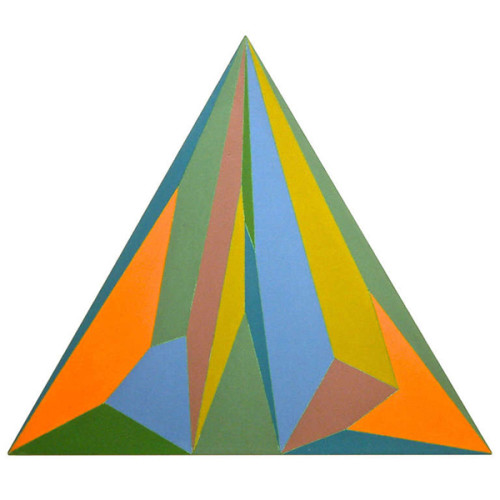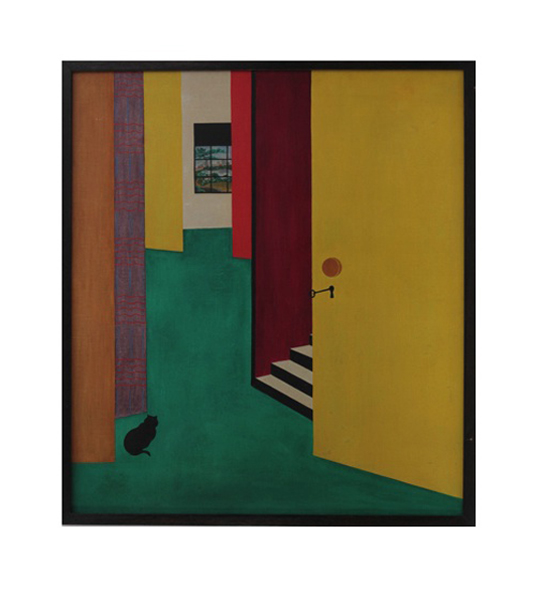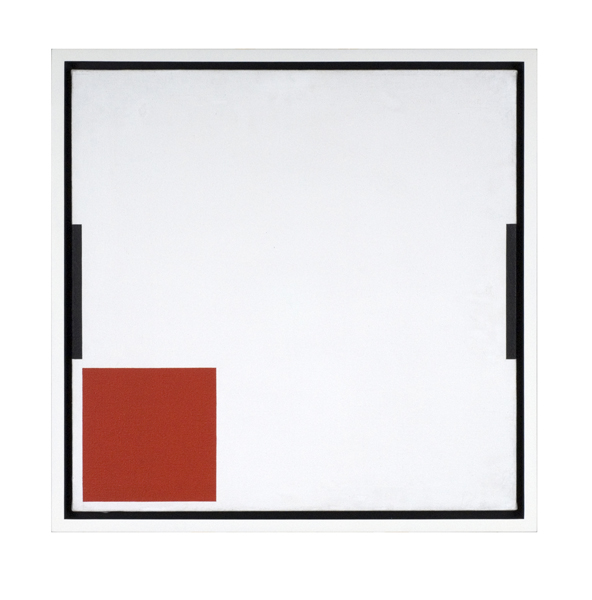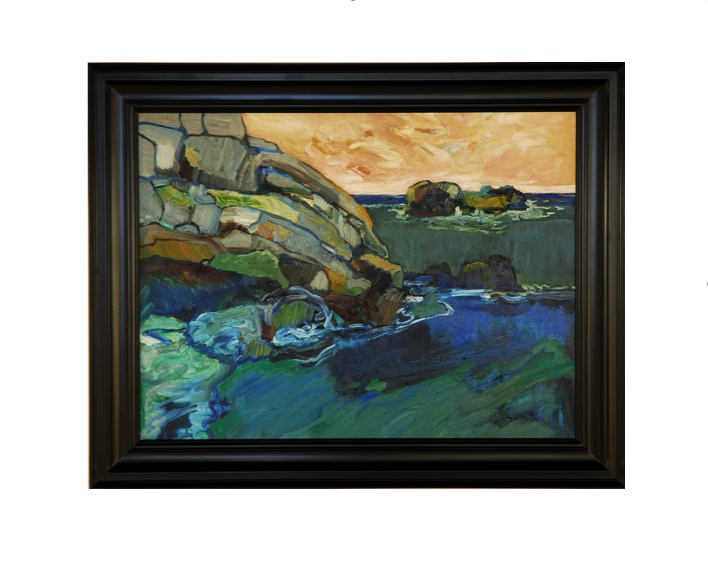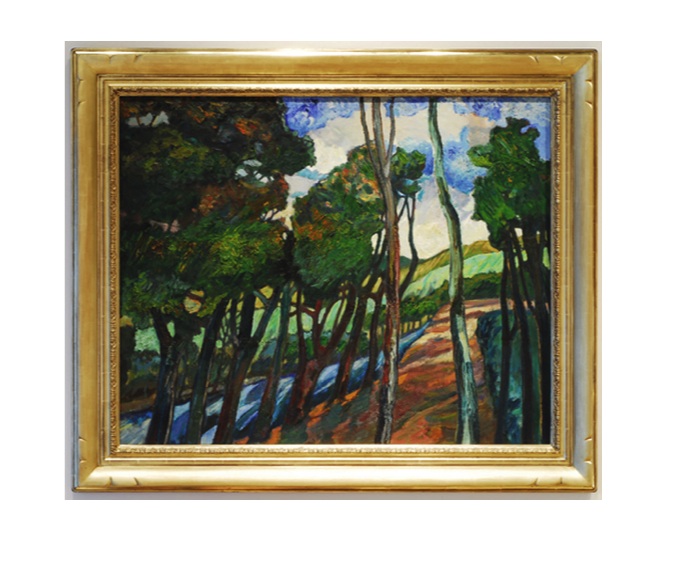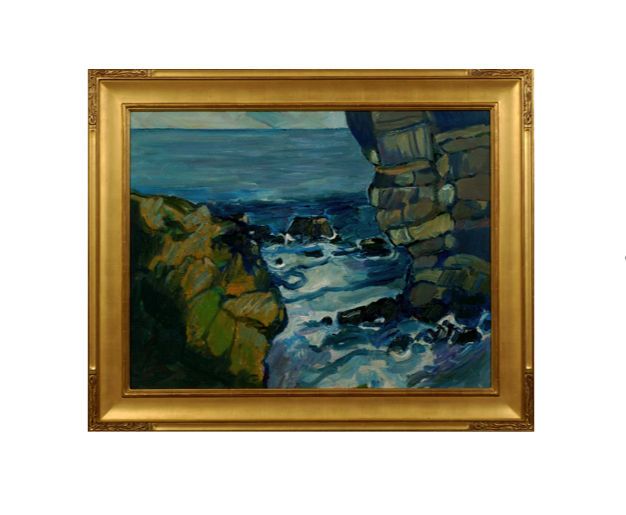canvas
-
Knox Martin, “Eight”, Magna and oil on canvas 1958
KNOX MARTIN (1923-) USA
Eight 1958
Magna and oil on canvas
Signed: Knox Martin on lower left on front of canvas, Knox M on back of canvas
Marks: From: CORE, 38 Park Row, New York 38, NY, To: Martin, Knox, Eight, 1958, Magna/Oil, 30×40, 700. (paper label), Fischbach Gallery, 799 Madison Avenue, New York 21, Knox Martin, Eight, C.O.R.E., Price $700 (paper label), Mr. Ned L. Pines, 605 Park Ave., New York 21, NY (address label).
Exhibited: Fischbach Gallery, New York 1963; I. Jankowski Gallery, New York, 1975
Provenance: Personal Collection of the artist; Private Collection New York
Canvas: H: 40 1/4” x W: 26 1/4””
Framed: H: 52 3/8” x W: 38 3/8”
From 1957 to about 1964, the spirit of art in New York City was moving in directions for which Abstract Expressionism had not prepared us. By 1965, the strokes, swipes, drips, and splatters of New York painting had given way to cool, laconic representations of the most ordinary of ordinary objects. It was a transformation in artistic culture in which intellectual rewards replaced, or at least supplemented, visual ones, and the whole philosophical face of art was beginning to disclose itself in a particularly vivid way. I saw Knox Martin’s paintings as embodying this transformative moment. In them, I thought, the tension between the two rival philosophies of art could be felt. the way I saw them: they appeared at first glance to be collages, made of large, irregular, overlapping swatches of patterned cloth. Some of the swatches were striped, some appeared to be decorated with circles. It must be conceded that stripes and circles belong to the vocabulary of one kind of abstract art, while the irregular shapes, which felt as though they had been torn from bolts of material, belonged to another.
So one might properly claim that Martin was synthesizing an expressionist abstraction with a geometrical one. For me, however, Knox’s stripes and circles evoked the life of the circus: the striped tents, the loudly patterned costume of clowns. And Martin’s colors—pistachio, raspberry, banana—were festive and impudent. That is why I felt that the paintings referred to vernacular reality, as much so as Campbell Soup cans or Coca Cola bottles. The circus was a recurring theme in modernist art, and I thought it appropriate for late modernist painting to reduce the circus to patterned rags expressive of its raucous gaiety.
-
Alyssa Monks “Push” Oil on Canvas 2006
ALYSSA MONKS (b.1977) USA
Push 2006
Oil on canvas
Signed: Alyssa Monks 2006 (on lower back of canvas)
Exhibited: DFN Gallery, New York 2006
Illustrated: American Art Collector, May 2006, p. 155
H: 30” x W: 56”
“Push” is somewhat of a response to the long tradition of bathtub paintings where a nude woman is displayed. However, the figure is me, the painter, so that the subject is also the artist, juxtaposing the objectification of women in that tradition. Also, the figure wears a black negligee and red lipstick, white makeup gently drips down the cheek, closing the door on naturalism.
At the New York Academy of Art, Alyssa Monks studied with Vincent Desiderio, Wade Schuman, Brenda Zlamany, John Jacobsmeyer, Harvey Citron, Deane Keller, Edward Schmidt, Steven Assael, Lisa Bartolozzi, Patrick Connors, Peter Cox, Jon DeMartin, Leonid Lerman, and Hong Nian Zhang. Alyssa’s sensibility of paint and color allows one to be seduced into the illusion of each image. Striving for anatomical and realistic accuracy, it is her intention to elicit a serious confrontation. The work requires attention to detail and a slow and rich execution. It is this artist’s concern to visually relate the contemporary human experience with sensitivity, empathy, and integrity.
-
Hank Pitcher, “Life Guard Tower”, Oil on canvas c. 2002
HANK PITCHER (b. 1949) U.S.A.
“Life Guard Tower” c. 2002
Oil on canvas
Signed (on back)
For more information see: Hank Pitcher Surf, exhibit. cat. (Santa Barbara: Sullivan Goss Gallery, 2003); Surfboard Wax – A History, Jefferson “Zuma Jay” Wagner (Atglen, PA: Schiffer Publishing Ltd., 2005).
Canvas H: 15 7/8” x W: 19 7/8”
Framed: H: 21 3/8” x W: 25 3/8”
Pitcher’s surfboard paintings are the symbol of California beach culture…strong, definite, positive and euphoric statements about life in California. The surfboard’s power as totem is seen in its power to convey identity: surfer, Californian, Hank Pitcher. All are identifiable from this symbolic representation. Hank Pitcher is the voice of California culture. At the beach, in the surf, approaching the foothills, in the mountains, on the spit of Point Conception, in the crags of Big Sur, at a beach campfire in Santa Barbara, Pitcher paints the icons of California’s culture.
Hank Pitcher’s paintings are grounded in a particular sense of place. He was born in Pasadena, California on July 20, 1949, but his family moved to Isla Vista, near Santa Barbara, when he was two years old. When they came to Isla Vista it was an outpost on the beach, and Goleta was a farm town where kids rode their horses down the avenue to buy candy at the store. He was a football star at San Marcos High School and was recruited by big-name universities. Instead of football, he chose to attend the College of Creative Studies, an alternative program within the University of California at Santa Barbara (UCSB) where he now teaches painting. He splits his time between painting and surfing, pursuing each with the commitment and energy of a linebacker.
-
Peter Svenson, “Triangle Painting”, Oil on canvas 1976
PETER SVENSON (b. 1944)
“Triangle Painting” 1976
Oil on Canvas
Signed: Peter Svenson 1976, Turkey Shoot (on the stretcher) and canvas on verso.
H: 41 ½” x W: 48”
Nationally recognized artist and writer Peter Svenson was born in 1944 and received a bachelor of arts degree from Tufts University and a masters of fine arts in painting from the University of North Carolina.
Svenson created “Turkey Shoot” in 1976 based on color field painting theories. The triangular shaped canvas is unusual in this style of painting, the lines are precise, the paint is thinly laid on the primed canvas in flat primary and secondary colors. “During the late 1950s and 1960s, color field painters emerged in Great Britain, Canada, Washington, DC and the West Coast of the United States using formats of stripes, targets, simple geometric patterns and references to landscape imagery and to nature.” Some of the artists of the Washington Color School included Gene Davis, Morris Louis, Kenneth Noland and Sam Gilliam.
Peter Svenson’s work relates to this group of Washington color field artists working in the style in the 1950s, 60s and 70s.
-
Dorothy Reno Grover, “California Interior with black cat”, Oil on canvas c. 1950’s
DOROTHY RENO GROVER (1908-1975) USA
“California Interior with black cat” c. 1950’s
Oil on Canvas
Canvas: H: 40″ x W: 34 1/2″
Framed: H: 42″ x W: 36 1/2″
Born in Dallas, TX on Sept. 10, 1908 into a pioneer Texas family. (Her grandfather was mayor of Dallas, and Brownsville, Texas is named for him.) Dorothy Reno moved to California with her family at age ten and settled in San Mateo. After graduating from Mills College, she obtained an M.A. degree from UC Berkeley. She wed radio announcer John B. Grover in 1931 and settled in Oakland. In 1971 she bought the former home of artist Glenn Wessels in Berkeley where she remained until her death.
-
Erik Saxon, “Untitled”, Acrylic on canvas 1975
ERIK SAXON (b. 1941) San Francisco, CA
Untitled 1975
Acrylic on canvas
Signed: Erik Saxon 74 75 (on back of frame)
Canvas H: 24” x W: 24”
Framed H: 26 1/4” x W: 26 1/4”
***24 layers of paint were applied to the surface and the painting is 24 inches high and wide. Erik Saxon was born in San Francisco in 1941 and now resides in New York City. He received both his Bachelor and Master of Arts from Berkeley (The University of California). Originally from San Francisco but based in NYC since 1968, Saxon was a core member of the Radical Painting Group active in NYC during the 1970s and 1980s. The RPG stressed a return to the core concerns of painting, focusing primarily on the monochrome. The group included Erik Saxon, Phil Sims, Merrill Wagner, Dale Henry, Doug Sanderson, Susanna Tanger, Anders Knutsson, Marcia Hafif, Jerry Zeniuk, Frederic Matys Thursz. In 1973 Saxon began making abstract work based on the grid format, initially using watercolor on paper and then industrial paint on raw canvas. The same year he began exploring the idea of monochromatic canvases – a series of acrylic drawings consisting of white and off-white squares arranged into groups of three to five panels – but tabled the idea a year later to focus his attention on paintings organized around a nine square grid structure. For the past thirty years, Saxon has worked with the monochrome and it’s relationship to its surroundings–the wall, the floor, its location within the exhibition space, and the viewer. In addition to his studio work, Saxon is a writer and has had his essays published in Artforum, Art in America, Appearances and other respectable art magazines. Radical Painting denotes an abstract art tendency in Europe and North America, which was in existence in the 1980s and 1990s and has to be seen in the light of Postmodernism. The term Radical Painting was used in the context of an exhibition at the Williams College Museum of Art in Williamstown (MA) in 1984 for the first time. It describes a self-referential art, which addresses topics of its immanent characteristics – especially color, but also image carriers, surface and structure. The Radical Painting artists and their monochrome painting are in the tradition of Post Painterly Abstraction of the 1950s and 1960s and shows notions of Minimal Art. The roots of radical art can also be found in the stylistic ambitions of Constructivism, Suprematism and Art Concret. In terms of style, radical painting is characterized by mostly monochrome works that focus on color effects, shading and material properties, entirely doing without external motifs. Radical Painting enables the observer to sensually experience the picture with its independently perceived color and light values, uniquely achieved by the painting technique, subtle coating methods or change of flows. Among the main artists of Radical Painting are Phil Sims, Marcia Hafif, Günter Umberg and Joseph Marioni; others radical artist are Jerry Zenuik, Andreas Exner, Frederic Matys Thursz, Rudolf De Crignis, Christiane Fuchs, Ingo Meller, Eric Saxon, Peter Tollens, Dieter Villinger, Ulrich Wellmann, Olivier Mosset and Winston Roeth.
Saxon’s works can be found in the following selected Public and Private Collections: artothek, Kolnisches Stadt Museum, Cologne, Germany. Bank of America, San Francisco. Fogg Museum, Havard University , Boston, MA Goteborg Museum of Art, Sweden Lita Hornik, New York IBM, San Jose, CA Wynn Kramarsky, New York Herbert Minkel, New York Mondriaanhuis, Museum voor Constructieve en Concrete Kunst, Amersfoort, Neatherlands. Morris and Helen Belkin Art Gallery, The University of British Columbia, Vancover,B.C., Canada Museo Cantonale d’Arte of Lugano , Switzerland Museum fur Kommunikation, Frankfurt, Germany Museum of Modern Art, Belgrade MOMA, Museum of Modern Art , New York . Gift of Wynn Kramarsky National Gallery of Art, Washington , D.C. UCLA Hammer Museum, Los Angeles , CA University of Kentucky Art Museum, Lexington, KY Yale University Art Gallery, New Haven, CT
-
Arrigo Varettoni de Molin, “Passaic Rooftops”, Oil on canvas 1932
ARRIGO VARETTONI DE MOLIN (1902-1985)
Passaic Rooftops 1932
Oil on canvas
Signed: A V de Molin ’32
Listed: Who’s Who in America, Series II, no. 11 (November 1, 1941) p. 6.
Exhibited: New Jersey State Annual, Montclair Art Museum, 1934
Canvas: H: 39” x W: 35”
-
Hubert Schmalix “Häuserbild” Oil on Canvas 1989
HUBERT SCHMALIX (1952-) Austria
Häuserbild 1989
Oil on canvas
Signed and dated on back: Schmalix 89
Exhibited: Galerie Krinzinger Vienna 1990 (Solo exhibition)
Illustrated: Nach Schiele, Tobias G. Natter and Thomas Trummer (Köln, Germany: Atelier Augarten, DuMont, 2006), p 142.
Provenance: Private Collection Vienna
For related works by Hubert Schmalix see: Hubert Schmalix, Lóránd Hegyi exhibition catalog (Museum Moderner Kunst StiftungLudwig Wien) November 19, 1994 – January 1995.
H: 85” x W: 49”
Hubert Schmalix was born in Graz, Austria, on December 17, 1952 and studied at the Vienna Art Academy from 1971 to 1976. By 1979 Schmalix was showing work at the forward-looking exhibition ‘Europa 79 – Kunst der 80er Jahre’ in Stuttgart. In 1983 the London Tate Gallery invited Schmalix to present work at ‘New Art’, an important survey of contemporary art. Schmalix has become well-known world-wide as an exponent of ‘New Art’, working with a retrospective glance at both classical art history and modern art. Schmalix focuses on the world of things and the human figure. Although the expressive gesture was the dominant feature of his 1980s work, it yielded early in the 1990s to stringent tectonic composition. In 1984 Hubert Schmalix went to the Philippines and on to the US, moving to Los Angeles in 1987. In 1986-87 Schmalix taught at the Academy for the Decorative and Applied Arts in Vienna and from 1997 he has been a professor at the Vienna Art Academy. Schmalix is a visiting professor at the University of California Los Angeles (UCLA). In 1993 his work was featured at the Venice Biennale and in 1998 he was awarded the Fine Art Prize of the City of Vienna. Schmalix has done several large fresco cycles in Salzburg and his work has been shown extensively at numerous international solo and group shows and most recently at Art Basel 2006.
The Kunstforum in Vienna is dedicating a major retrospective show to Hubert Schmalix from May 6th – July 12th, 2015.
“I’m not nervous or angry when I paint, but well rested and concentrated. Each stroke of the brush is important! I’ve painted a whole lot of beautiful pictures this way.” (Hubert Schmalix)
-
Hank Pitcher “Mr. Zogs board at Coal Oil Point” Oil on canvas, laid on board 2006
HANK PITCHER (b. 1949) U.S.A.
“Mr. Zogs board at Coal Oil Point” 2006
Oil on canvas, laid on board
Signed: Mr. Zogs board at Coal Oil Point (with chalk on back),
Hank pitcher 2006, Mr. Zogs Board at Coal Oil Point
For more information see: Hank Pitcher Surf, exhibit. cat. (Santa Barbara: Sullivan Goss Gallery, 2003); Surfboard Wax – A History, Jefferson “Zuma Jay” Wagner (Atglen, PA: Schiffer Publishing Ltd., 2005).
Canvas: H: 84” x W: 36”
Framed: H: 87” x W: 39”
Pitcher’s surfboard paintings are the symbol of California beach culture…strong, definite, positive and euphoric statements about life in California. The surfboard’s power as totem is seen in its power to convey identity: surfer, Californian, Hank Pitcher. All are identifiable from this symbolic representation. Hank Pitcher is the voice of California culture. At the beach, in the surf, approaching the foothills, in the mountains, on the spit of Point Conception, in the crags of Big Sur, at a beach campfire in Santa Barbara, Pitcher paints the icons of California’s culture.
Hank Pitcher’s paintings are grounded in a particular sense of place. He was born in Pasadena, California on July 20, 1949, but his family moved to Isla Vista, near Santa Barbara, when he was two years old. When they came to Isla Vista it was an outpost on the beach, and Goleta was a farm town where kids rode their horses down the avenue to buy candy at the store. He was a football star at San Marcos High School and was recruited by big-name universities. Instead of football, he chose to attend the College of Creative Studies, an alternative program within the University of California at Santa Barbara (UCSB) where he now teaches painting. He splits his time between painting and surfing, pursuing each with the commitment and energy of a linebacker.
-
Hubert Schmalix “Mount Washington” Oil on Canvas 2005/2006
HUBERT SCHMALIX (1952-) Austria
Mount Washington 2005/06
Oil on canvas
Signed and dated on back: Schmalix 05 06
Provenance: Hubert Schmalix Vienna
For related works by Hubert Schmalix see: Hubert Schmalix, Lóránd Hegyi exhibition catalog (Museum moderner Kunst Stiftung Ludwig Wien) November 19, 1994 – January 1995.
H: 69” x W: 51”
Hubert Schmalix was born in Graz, Austria, on December 17, 1952 and studied at the Vienna Art Academy from 1971 to 1976. By 1979 Schmalix was showing work at the forward-looking exhibition ‘Europa 79 – Kunst der 80er Jahre’ in Stuttgart. In 1983 the London Tate Gallery invited Schmalix to present work at ‘New Art’, an important survey of contemporary art. Schmalix has become well-known world-wide as an exponent of ‘New Art’, working with a retrospective glance at both classical art history and modern art. Schmalix focuses on the world of things and the human figure. Although the expressive gesture was the dominant feature of his 1980s work, it yielded early in the 1990s to stringent tectonic composition. In 1984 Hubert Schmalix went to the Philippines and on to the US, moving to Los Angeles in 1987. In 1986-87 Schmalix taught at the Academy for the Decorative and Applied Arts in Vienna and from 1997 he has been a professor at the Vienna Art Academy. Schmalix is a visiting professor at the University of California Los Angeles (UCLA). In 1993 his work was featured at the Venice Biennale and in 1998 he was awarded the Fine Art Prize of the City of Vienna. Schmalix has done several large fresco cycles in Salzburg and his work has been shown extensively at numerous international solo and group shows and most recently at Art Basel 2006.
-
Peter Canty, “Pacific Cove”, Oil on canvas 2001
PETER CANTY (b. 1938) USA
Pacific Cove 2001
Oil on canvas
Signed: P. Canty 2001, Santa Cruz, CA 5 (in a circle on back)
Canvas size: H: 30” x L: 40”
Framed size: H: 38” x L: 48”
Peter Canty received his BA in art from the Chouniard Art Institute, Los Angeles (now California Institute of the Arts) and an MA from the University of California, Santa Cruz in 1969. Heavily influenced by the Post-Impressionist masters Van Gogh, Gauguin and Cezanne, in his own he words he describes his interest in landscapes, believing they are, “the best vehicle for motion, force, and color dynamics.” Although his work reference realistic subjects, Canty’s imagery is drawn strictly from his own imagination.
-
Peter Canty, “Cypress Grove”, Oil on canvas 2005
PETER CANTY (b. 1938) USA
Cypress Grove 2005
Oil on canvas, lemon gold hand carved frame
Signed: P. Canty, 05 (on back of canvas in black)
Canvas size: H: 39 1/2” x L: 49 1/2”
Framed size: H: 49” x L: 59”
Peter Canty received his BA in art from the Chouniard Art Institute, Los Angeles (now California Institute of the Arts) and an MA from the University of California, Santa Cruz in 1969. Heavily influenced by the Post-Impressionist masters Van Gogh, Gauguin and Cezanne, in his own he words he describes his interest in landscapes, believing they are, “the best vehicle for motion, force, and color dynamics.” Although his work reference realistic subjects, Canty’s imagery is drawn strictly from his own imagination.
-
Peter Canty, “Pacific Cove”, Oil on canvas
Peter Canty received his BA in art from the Chouniard Art Institute, Los Angeles (now California Institute of the Arts) and an MA from the University of California, Santa Cruz in 1969. Heavily influenced by the Post-Impressionist masters Van Gogh, Gauguin and Cezanne, in his own he words he describes his interest in landscapes, believing they are, “the best vehicle for motion, force, and color dynamics.” Although his work reference realistic subjects, Canty’s imagery is drawn strictly from his own imagination.
-
Peter Canty, “Orange Flowers”, Oil on canvas
PETER CANTY (b. 1938) USA
“Orange Flowers”
Oil on canvas
Signed: Canty
Framed size: 33″ x 27″ x 3″
Peter Canty received his BA in art from the Chouniard Art Institute, Los Angeles (now California Institute of the Arts) and an MA from the University of California, Santa Cruz in 1969. Heavily influenced by the Post-Impressionist masters Van Gogh, Gauguin and Cezanne, in his own he words he describes his interest in landscapes, believing they are, “the best vehicle for motion, force, and color dynamics.” Although his work reference realistic subjects, Canty’s imagery is drawn strictly from his own imagination.
-
Arrigo Varettoni de Molin, “Harmony”, Oil on canvas 1945
ARRIGO VARETTONI DE MOLIN (1902-1985)
Harmony 1945
Oil on canvas
Signed: de molin 1945 (lower left on front of canvas)
For more information see: Who’s Who in America, Series II, no. 11 (November 1, 1941) p. 6.
Canvas: H: 38” x W: 44”
Framed: H: 45 5/8” x W: 51 ½”
-
Karl Benjamin, “Geo-metricized figure”, Oil on canvas 1954
KARL BENJAMIN (1925-2012) USA
Geometricized figure 1954
Oil on canvas
Signed: Benjamin 54 (lower left)
For more information see: Dictionnaire des Peintres, Sculpteurs, Dessinateurs et Graveurs, Vol. 1 to 10, E. Bénézit (Paris: Librairie Gründ, 1976).
Canvas: H: 17″ x W: 6″
Framed: H: 24 1/2″ x W: 13 1/2″
Karl Benjamin was born in Chicago, IL in 1925. He received his BA from the University of Redlands, CA and his MFA at Claremont Graduate School, CA. Benjamin belonged to the Hard Edge group of West Coast painters led by John McLaughlin during the 1950s, 60s and early 70s. He was awarded the National Endowment for the Arts Grant for Visual Arts in both 1983 and 1989. His work has been featured in numerous museum exhibitions and is included in the public collections of the Los Angeles County Museum of Art; Museum of Contemporary Art, Los Angeles; Museum of Modern Art, Israel; Oakland Museum, Oakland, CA; San Francisco Museum of Modern Art, CA; Seattle Art Museum, WA; and the Whitney Museum of American Art, NY, among others. For many years, Benjamin taught painting at Pomona College and Claremont Graduate School, and currently is Professor Emeritus. He lived in Claremont, CA.
-
Gianni L. Cilfone “After the Rain” Oil on canvas 1928
GIANNI L. CILFONE (1908-1990) USA
“After the Rain” 1928
Oil on canvas, contemporary quarter sawn oak pegged frame with yellow gold filet.
Signed: Cilfone, 1928 (lower left corner)
Marks: Illinois Academy of Fine Arts, Second Annual Exhibition 1928, Gianni L. Clifone, 905 South Ashland Boulevard, “After the Rain,” $500 (paper label).
Exhibited: Illinois Academy of Fine Arts, Second Annual Exhibition 1928, Art Institute of Chicago 1928
For more information see: Who Was Who in American Art (Madison, Conn.: Sound View Press, 1985) p. 115.
Canvas: H: 30” x W: 40”
Framed: H: 38” x W: 48”
Gianni Cilfone emigrated with his family from San Marco, Italy to Chicago at the age of five. After studying at the Art Institute of Chicago, Cilfone took lessons from Hugh Breckenridge and John F. Carlson. His consistently won many prizes from the Chicago Gallery Association throughout the 1930s and 40s. He exhibited at the Hoosier Salon between 1949 and 1958, at the North Shore Arts Association, at the Association of Chicago Painters and Sculptors, and at the Art Institute of Chicago in 1919 and 1928.
-
Arrigo Varettoni de Molin, “Cocktail Hour”, Oil on canvas 1937
ARRIGO VARETTONI DE MOLIN (1902-1985)
Cocktail Hour 1937
Oil on canvas
Signed: Arrigo V de Molin (on front of canvas), #4 Cocktail Hour, Arrigo Varettoni de Molin, 323 West 4th Street, 79 Horatio Street (paper label attached to back of frame)
Listed: Who’s Who in America, Series II, no. 11 (November 1, 1941) p. 6.
Exhibited: The Society of Independent Artists, 1939; Vendome Art Galleries, 1941
Painting reviewed: “Three Newcomers Enliven the Season’s Beginning” Roy Finch, The New York Herald Tribune (September 7, 1941).
Canvas: H: 42” x 36”




